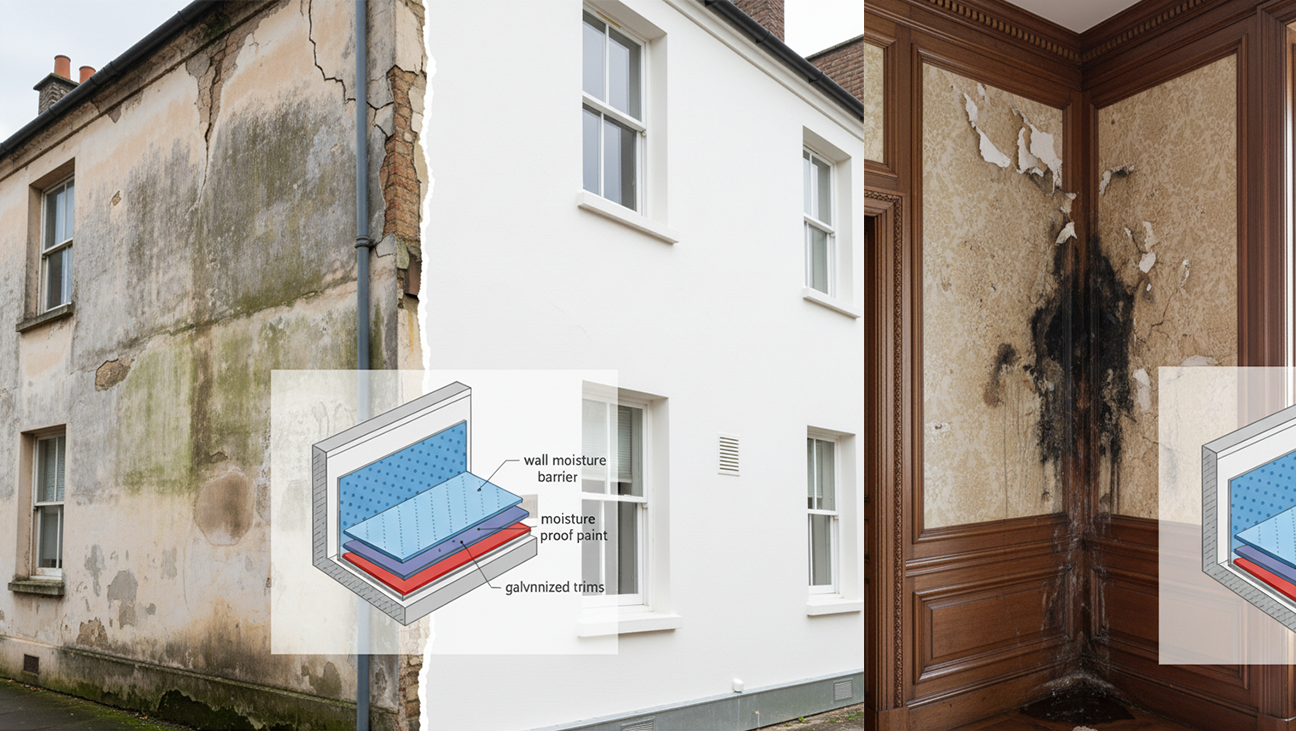
Moisture in walls is one of the most common issues faced by our parents and today by us, may be by our kids in future. Whether you live in a humid region, experience heavy rains, or have basement walls exposed to groundwater, wall moisture problems can cause serious structural and health issues. Solutions that help you protect your property from long-term damage.
What Causes Wall Moisture?
- Poor ventilation leading to condensation
- Leakage from plumbing or roofing or roof joints
- Absence of a proper wall moisture barrier
- Groundwater seepage in basements and foundations
- Damaged plaster or exterior finishes or cracks
How to Check and Measure Wall Moisture
The first step in fixing the issue is to identify the moisture levels:
- Use a wall moisture meter
- Tools like a wall moisture checker, wall moisture detector, or wall cavity moisture meter can give you a reading.
- For accuracy, check if your wall moisture level is within the acceptable range (generally below 12% is considered normal).
How to Prevent Wall Moisture
- Install a wall moisture barrier for basement or exterior wall moisture barrier to block seepage.
- Use retaining wall moisture barriers and galvanized trims to prevent rising dampness.
- Apply wall moisture protection coats, sealants, and anti-moisture coatings.
- Improve ventilation with wall moisture vents and dehumidifiers.
How to Fix Wall Moisture Issues
If your wall already has moisture:
- Use a wall moisture extractor or wall moisture dryer to remove trapped water.
- For wet walls, apply a wall moisture sealant, wall moisture-proof paint, or wallpaper to preserve the surface.
- For basements, add a concrete wall moisture barrier or external wall moisture treatment.
- Fix cracks Install moisture wall panels in high-damp zones and repaint damaged parts.
Moisture on Walls under Particular Conditions
- Walls in the basement put in place a waterproofing or moisture barrier for the basement walls.
- Water-resistant panels and moisture wall boards should be used in bathrooms.
- The bedrooms Seal leaks and use wall moisture absorbers to fix the moisture on the wall behind the bed.
- Walls of the garage: Install a moisture barrier on the garage wall to prevent moisture from destroying stored items or automobiles.
Standard Levels of Wall Moisture
- A typical wall moisture reading is contingent upon the following:
- Drywall: 5% to 12%
- Fencing made of wood: 8–16%
- 12% or less for brick and concrete is acceptable.
- You must treat your wall right away if the moisture readings are higher than these.
NextBC Expertise in Wall Moisture Solutions
At NextBC.in, we provide expert consultation and materials for:
- Wall moisture control systems
- Professional wall moisture treatment
- High-quality exterior wall moisture barriers
- Wall panelling for high moisture areas
- Best practices on how to remove wall moisture and stop it permanently
Conclusion
Wall moisture is not just an aesthetic problem; it’s a structural and health hazard. Whether you’re looking for guidance on how to fix wall moisture, searching for a wall moisture meter nearby, or planning to install a wall moisture barrier, NextBC is here to help. Protect your property today—because the cost of prevention is always less than the cost of repair.
Visit www.nextbc.into learn more about wall moisture solutions and professional services.
Thanks
Our Related News

Choosing Aesthetics Over Functionality: A Design Dilemma for Homeowners
When designing your dream home, it’s tempting to prioritize beautiful aesthetics—sleek countertops, statement lighting...

Ignoring Natural Lighting: A Common Oversight in Home Design
When designing a home, every decision—from color palettes to materials—contributes to the space's...
Comment(0)
No Comment Yet! Archite post comment box is empty!
Post Your Comment